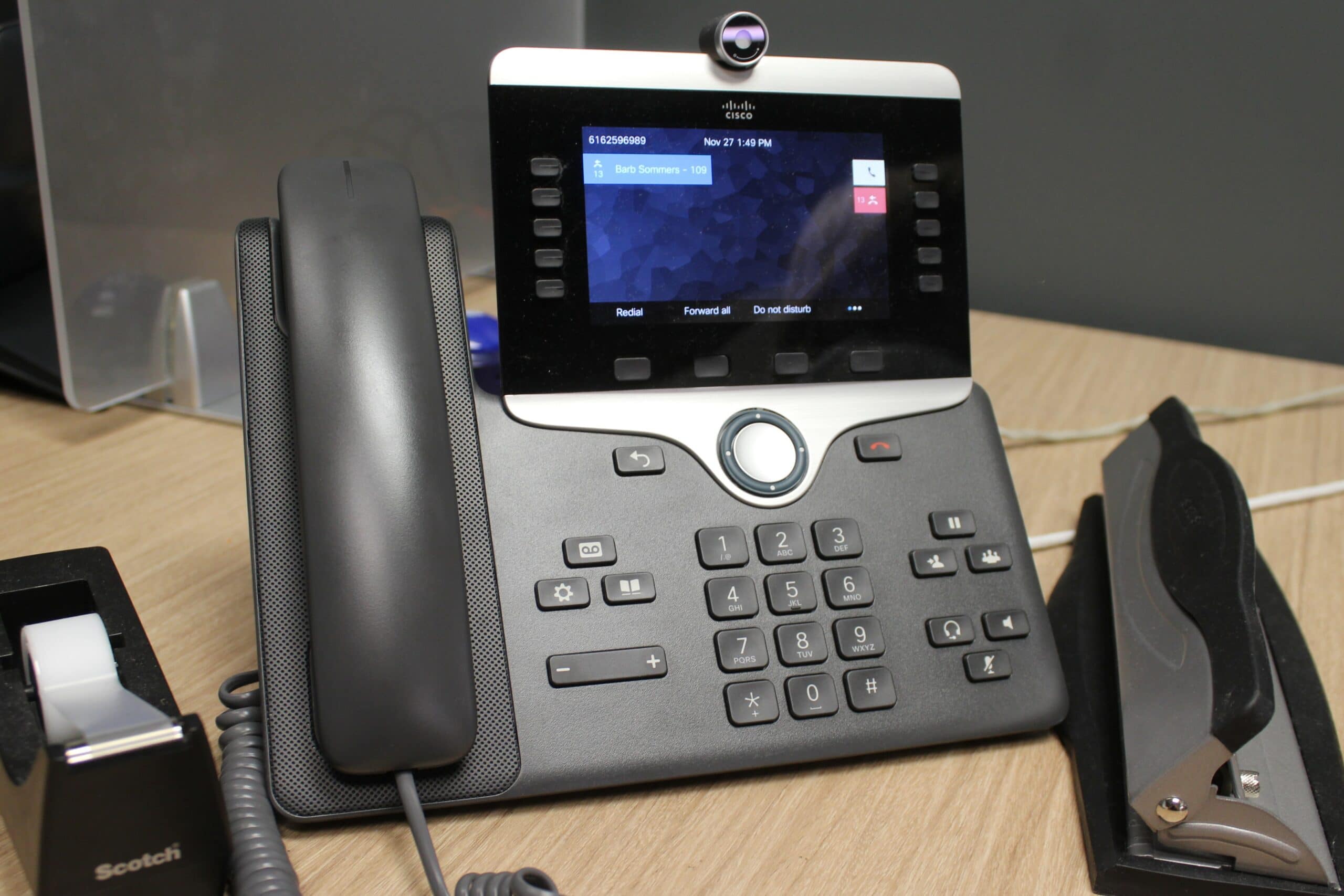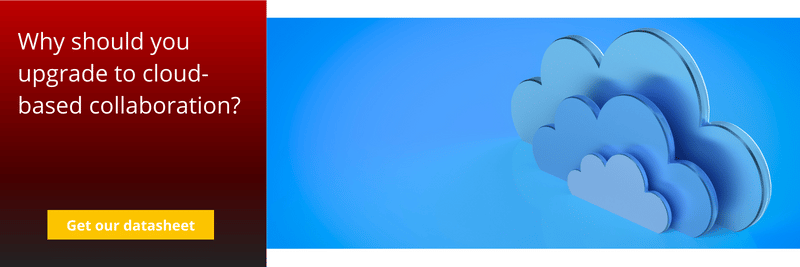Regardless of how familiar you are with cloud-hosting, if you’re moving your collaboration system to the cloud, you likely have questions.
If you’ve been warned there are problems with cloud-hosting calling, they do exist. However, so do their solutions.
At The KR Group, our customers frequently ask about what problems they might experience if they decide to move ahead with cloud-hosting collaboration.
Some of the problems we point out include:
- Internet connectivity and bandwidth issues
- Reduced feature set
- Updates are out of your control
- A narrower set of compatible phones
However, we also have recommendations for working with each one.
Problem #1: Internet connectivity and bandwidth issues
Choosing cloud-hosted calling means you’ll be tied to an internet connection to access everything for your collaboration solution.
Having a poor internet connection or low bandwidth can seriously impact the effectiveness of your collaboration system.
Two frequent problems customers who experience this issue notice include:
1. Latency
Latency refers to how long it takes between sending and receiving data. Distance and ineffective internet infrastructure can impede how fast this takes.
With cloud-hosted phone calls, audio doesn’t go directly from caller to receiver, but it also has to travel to the data center hosting cloud platforms.
If your connection is sensitive to latency already, this can make enough of a negative impact to seriously impair your communications.
2. Jitter
You might experience jitter if your internet connection isn’t stable and has lots of speed fluctuations, which is a common issue with shared bandwidth internet service providers.
Data calls are transferred in data packets. The order of these data packets is important to accurately reconstruct the information being transferred back into audio form.
A bad internet connection can cause problems on how these packets are come through, such as:
- They may not all be received.
- They may be received in the wrong order.
- They may be received at the wrong time.
All of these issues can cause the audio to sound choppy, much like a bad cellular call or an old speakerphone.
Solution: Test your connection
Good collaboration providers will have metrics in place for you to test if you have enough bandwidth and a stable connection to support cloud-based calling.
With that information, your IT consulting company can advise you on ways to prioritize collaboration traffic within your network.
If bandwidth or connection is only a mild issue, you may be able to solve your problems by limiting how many devices are connected at one time or additional configuration of your existing network infrastructure.
However, if you have very low bandwidth or an unreliable connection, you may need to consider an on-premises solution if you are not able to upgrade with your existing internet service provider or move to a new one.
Problem #2: Reduced feature set
Many cloud calling platforms offer a reduced feature set compared to their on-premises counterparts.
This is true with Cisco’s cloud collaboration solution, Webex Calling.
When compared to a Cisco on-premises solution, like Cisco Business Edition 6000 (BE6K), Webex Calling doesn’t offer the same granular level of control of the overall system.
For example, if you want to host an audio-only conference call with BE6K, you are able to configure the “Conference Now” feature, and everyone can dial in. With Webex Calling, however, you’ll need a full Webex meeting for conference bridges.
Another example would be call routing capabilities. Cisco BE6K allows for best-in-class enterprise call routing. Meanwhile, Webex Calling does not offer much beyond the ability to restrict international dialing.
Solution: Consider if cloud-calling is best for your needs
There are a lot of great things about cloud-hosted calling, including many useful features. However, if you find yourself gravitating to the more expansive feature set of an on-premises solution, something like Cisco BE6K might be a better option.
Problem #3: A narrower set of compatible phones

Along with having fewer features, Cisco Webex Calling also has fewer physical desk phones it is compatible with than Cisco BE6K or BE7K.
For Cisco Webex Calling, the desk phones are limited to the 6800, 7800, and 8800 series.
If you already have a Cisco collaboration system but aren’t using compatible phones, this means you’ll still have to purchase compatible phones, which can be costly.
Solution: Use other devices
The good news is that since you can access your cloud calling system on other devices, such as a smartphone or laptop, it isn’t necessary to have a desk phone.
Problem #4: You’re completely reliant on the internet
Cloud-hosting is only possible with an internet connection. Without one, you’re locked out of whatever is hosted on the cloud. With cloud-based collaboration, this means your ability to make and receive phone calls.
If your internet goes down, you lose an important part of your business operations.
If you’re using a mobile application, you can temporarily switch to using LTE data. That connection isn’t as reliable, though, so it should be reserved for emergencies.
Solution: Have a back-up internet connection
One solution many businesses rely on is having a back-up internet connection. Redundancy is important throughout your network, and your internet connection is no different.
Problem #5: You don’t get to determine upgrades
Cloud hosting, regardless of the system, means your technology is completely hosted on the infrastructure of the provider.
They’ll be the ones to dictate when upgrades are implemented as well as what features are modified or omitted during an upgrade.
It also means if you dislike the upgrade or certain changes don’t work with your business, there is no way to go back.
Solution: Acceptance
Unfortunately, this specific problem doesn’t have a workaround, and the best solution we have is to embrace your provider’s upgrades.
To help you prepare for change, providers will tell you ahead of time when they’re planning an upgrade.
The best providers, including Cisco, have a system in place where they allow customers to see planned changes and provide advanced notifications of what those changes are and when they’ll go into effect.
In the end, part of having a cloud-hosted calling system is accepting you don’t have control over updates and embracing the fact that you don’t need to worry about them.
You will have access to release notes and information about what the upgrade entails and can let the provider know if you have any issues (although that doesn’t guarantee they’ll be resolved any faster than an on-premises solution).
Choosing cloud-hosted calling
When it comes to technology, no solution is free from problems, and cloud-hosted calling, including Cisco Webex Calling, is no exception.
There are solutions to consider that will likely make it possible for you to still use cloud-hosted calling if internet reliance and compatible phones are concerns of yours.
If other problems, like the reduced feature set and inability to determine a schedule for updates, don’t work for your business, you might want to consider an on-premises collaboration solution instead.
For more information about Cisco’s cloud-hosted calling option, Webex Calling, download our free infographic.


